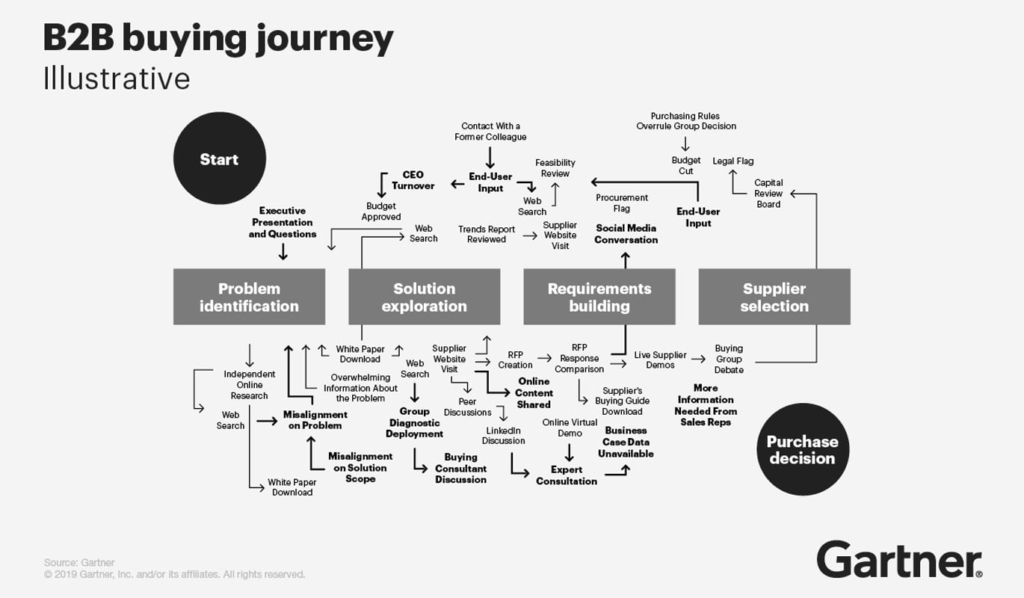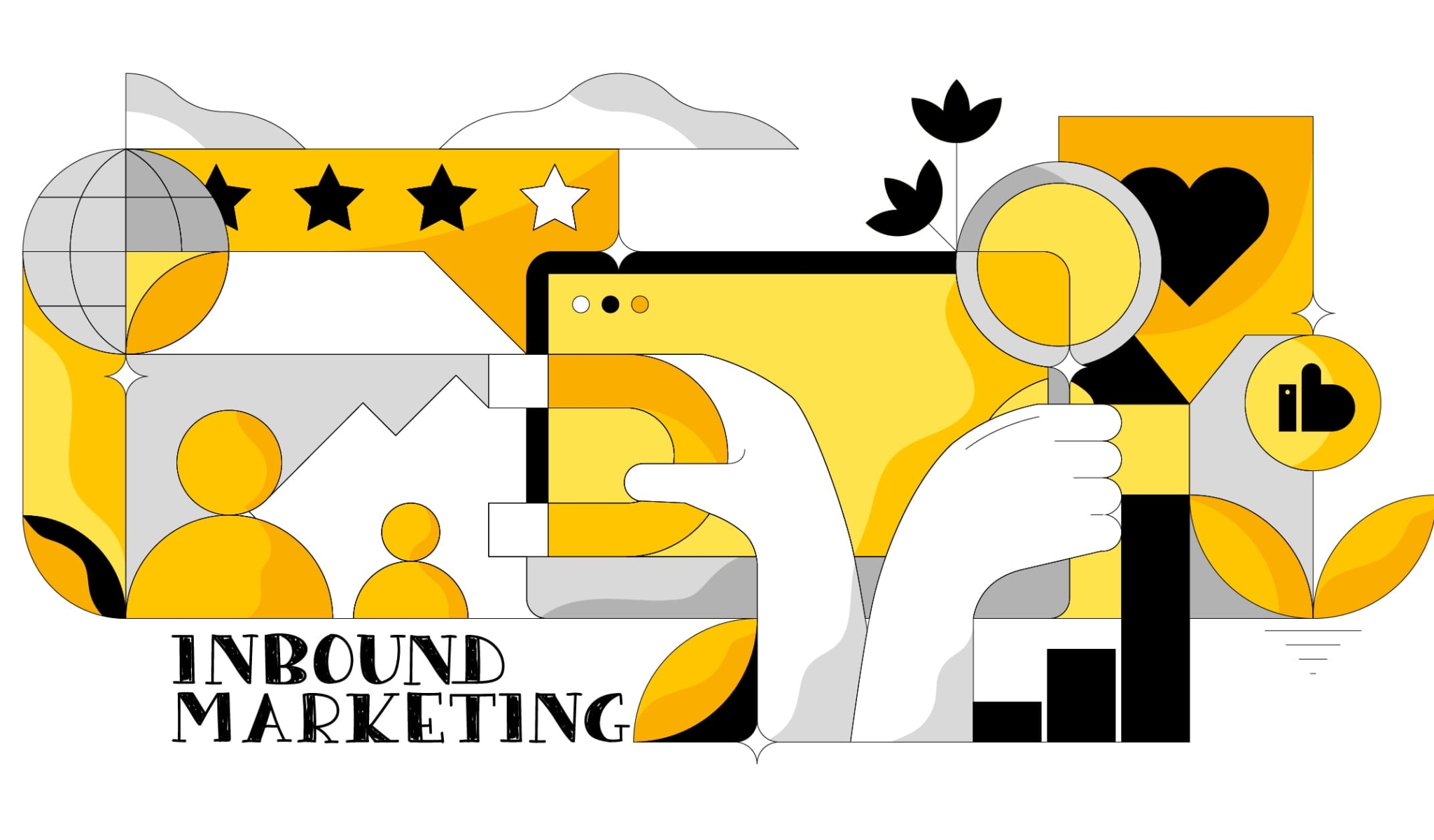When it comes to a B2B buyer’s journey, companies used to rely on expert sales teams to showcase solutions and close business.
But today, sales reps are only a small part of the buying process. In fact, Gartner has found that they only have around five percent of a customer’s time before they decide to purchase.
With more information readily available online, customers increasingly do their own research and gather data before approaching companies. This may make it harder for sales teams, but it also presents an opportunity for B2B companies. If you can position your business well online and establish yourself as an authority, you have an extra chance to reach potential buyers and turn them into loyal customers.
The path to purchase
The B2B buyer’s journey now includes multiple steps and isn’t necessarily linear. Some customers cycle through several steps multiple times, and others not at all. Gartner research shows that increasingly B2B buyers research online, taking up about 27 percent of their time, while 18 percent of the time is spent researching independently offline.
It is no wonder that 77 percent of B2B buyers say that their latest purchase was very complex or difficult.

Only once they are armed with data they have found online do they speak to sales teams, which means those sales reps are then forced to play catchup to differentiate their solutions and close the sale.
Further data research from Sana found that 75 percent of B2B product purchases are already made online, with buyers looking to increase that further. In total, 47 percent of buyers conduct web searches to look for information during the purchasing process, and a quarter predicts that automation will further change the B2B buying role in the next few years.
The changing consumer
As a business, it’s vital to study what influences a B2B buyer’s journey. Buyers’ wants, needs, and behaviors are evolving faster than ever, and B2B businesses must keep up with their B2C counterparts, better-supporting buyers to drive sales.
For example, customer expectations for personalized experiences are significantly higher now than they were just a few years ago. They want to feel like you’re selling directly to them and not just to anyone who wants your product or service. By creating an orchestrated customer experience strategy, you can increase trust amongst your customers and boost revenue overall. In fact, a leading technology manufacturer grew their sales by 4.9 percent by simply shifting their focus to things like customer retention, contract renewal, and product refresh.
The modern buyer demands more and different solutions and is much more fickle. According to Accenture, most customers are 57 percent through the buying process before meeting with a company representative. By adapting to evolving customer behaviors, you can create opportunities to support buyers in their self-reliant research.
Taking the journey online
If you want to create an effective sales and marketing strategy to influence B2B buyers, you need to start with the information they search for and find online. This involves first understanding the unique customer journey and then looking for gaps in knowledge and information that you can provide. It’s about more than just managing different channels, you want to create an ecosystem that offers resources, information, and processes online and offline so you can create a whole customer experience.
So how can you influence B2B buyers’ research online? It can be as simple as upgrading your website and producing a regular blog tackling key challenges your buyers face and providing in-depth analysis and solutions. Or it can become as developed as regular podcasts, colorful infographics, a targeted email marketing strategy, and social media to connect with buyers on a more informal level.
Let’s start with your website. If it hasn’t been updated in a while, you’ll want to look at that content and ensure it is search engine optimized so that you appear in search engine results. You’ll also want to concentrate on user experience, ensuring you’re answering potential buyer questions and making it easy to navigate through the site.
By shifting resources (economic, but above all human) into creating more value-added digital experiences for your customers, through all of the above channels, you are simultaneously offering a service to your customers and investing in the future of your company. In fact, this activity should be considered business development in its own right.
Your customers will interact with your brand, better understand what you stand for and find all the information they need. All this, even before you’ve met them!
Going beyond your website

While your website is a key place to start, many other online activations can help you reach your target audience.
By producing regular blog posts, videos or even podcasts, you also signal to search engines that you are a reliable content provider, which helps you rank online. Remember, in fact, that content is the gasoline that feeds search engines. It also helps you build a reputation as an expert in your field among buyers conducting their research online.
You need to ensure that this content stands out from the crowd and doesn’t just repeat other information found on the web. It’s about offering something unique and exciting, backed up by facts that help build trust between you and your customers.
One form of content you shouldn’t ignore is case studies. They are valued the most by customers as they display a specific success story with relevant details that they can relate to. It should state what the previous customer’s problem was and exactly what you did to solve it. This allows the reader to envision what you could do for them in the future.
It’s about more than just stating how great your business is. Make sure that your content is always customer-centric, they want to know what your business will do for them and the benefits they’ll experience purchasing from you.
Add social and email marketing to the mix. Creating content is a time-consuming activity, so once it’s published it should be leveraged as much as possible.
Always adapt your content to the channel that hosts it. On social media, for example, take the opportunity to present yourself in a fresher, more informal way than on more institutional channels.
A recipe for success
Your B2B buyer’s journey is complex, and buyers are increasingly taking it upon themselves to conduct their own research before approaching companies. So you need to adapt to this new journey, helping buyers switch between online and offline, creating ecosystems of information and insights, so they can absorb information about your solutions on their own terms.

Nowadays, sales representatives are one of the sales channels, likely the most important for the phases that rely on trust and relationships, such as closing, upselling and cross-selling. On the other hand, digital channels are becoming increasingly important for the acquisition of new customers.
Today more than ever, it’s essential that marketing and sales work as a well-oiled machine, to feed off each other and make the modern buying process sustainable and profitable.



